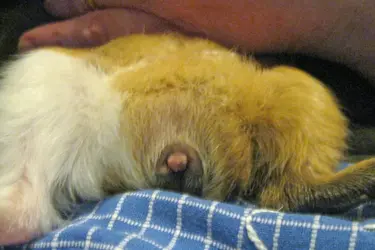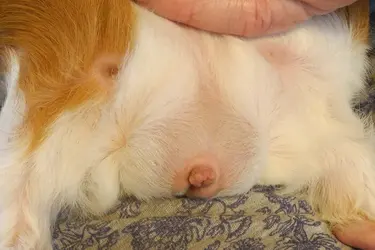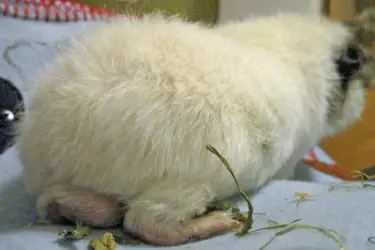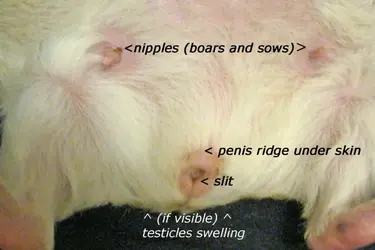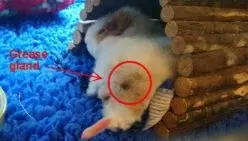1 Penis and Semen Fluid
- Penis (Prongs, 'cauliflower willy, strangled and prolapsed penis)
- Semen fluid (Semen rods and 'boar glue')
- Smegma
2 Perianal Sac and Impaction
- White paste in anal sac
- Impaction
- Fly strike
3 Testicles and Neutering Post-op Complications
- Testicles (descending, undescended and swellings in the area)
- Neutering post-op complications
4 Nipples and Mammary Tumours
- Nipples and belly button
- Mammary tumours
5 Grease Gland
This guide is a collection of information that addresses boar specific problems of mainly the reproductive tract and anal sac. It will hopefully make it easier for you to work out what is going on and when to see a vet.
We strongly recommend to get into the habit of a weekly weigh-in, body check and any necessary grooming. Some boars can be very messy and may need more frequent attention (especially with impaction or as teenagers) while others only need a thorough check once a month. We do however recomment that you have a weekly feel of the penis area of any hard bits (smegma or rods) as well as checking the the anal sac (which in neutered boars is much smaller), grease gland and the usual cuddling body feel that gently covers the whole body when feeling for lumps or anything unusual.
Our Boar Care guide with lots of pictures is there to help with the regular care side of boar maintenance:
We also recommend to take reference pictures once a year to save in a special so you can look up how your boy's 'normal' looks when you have concerns about any body part.
1 Penis and semen fluid
The penis is surrounded and protected by the internal tissue of the penis shaft. The round 'button' you see when you look at the genitalia is actually sac tissue and not the penis itself. In order to look at the penis, you need to express it fully by gently pushing on the hard penis shaft under the skin from the belly side towards the opening. Because it is a proteced place, semen fluid, grease and dirt can build up. In never checked boars this can build up to the degree that an rather nasty infection/abscess can come up. Any swelling in the groin area needs to be vet checked.
Penis
Prongs
- Guinea pig boars have two protrusions on their penis, like horns. This is another variation of ‘normal’ so is nothing to worry about!
- They are very often not visible upon penis inspection, but boars use them to keep hold of a moving sow when they mate.
- Some boars have only got one or no prongs at all.
However, the absence of prongs is NOT an indication of a boar's infertility, as veterinary textbooks maintain without substantion. There is some rather happily wheeking verifiable proof that says otherwise.
Picture from Stewybus showing one penis prong
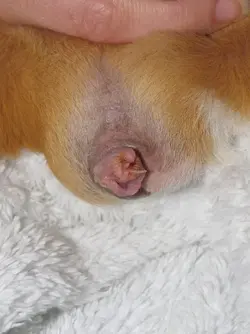
Cauliflower willy'
-‘Cauliflower willy’ is the term used when the foreskin isn’t as tidy and is more ‘frilly’ in appearance. This may (or may not) mean that it is trickier to keep clean and occasionally the penis itself protrudes which can cause it to get caught or damaged unintentionally.
- In this case your boar would need more frequent checks (at least daily) to make sure everything is safe and healthy.
- Also see a vet if you notice changes to the willy (infection).
Picture from MintyandGary
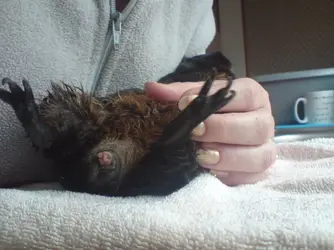
Merrypip's Angus showing debris & hair around the penis
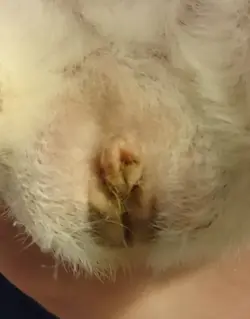
Strangled Penis
Please always check for problems if your boy seems to be constantly fussing about his penis. Boars do masturbate but nonstop attention can be a sign that there is a problem/pain issue in the penis shaft.
Make sure there is nothing caught around the shaft that could interfere with blood flow; especially if you have long-haired piggies in the same cage. The penis will show a blueish colour past the obstruction if the circulation is compromised. The consequences of a cut-off circulation are dire.
See a vet asap if you cannot remove any tightly looped hair yourself! This is an emergency.
The normal colour for a penis tip is dark ruby into maroon (see Hywel's picture above).
Prolapsed penis
-The penis can sometimes not retract properly. Generally the problem rights itself. With a boar with a more persistent retraction problem, a lubricating human gel like KY gel can help.
- In some cases the penis cannot retract itself and hangs out permanently. It needs stitching back by a vet to prevent the risk of injuries and infection. It is a minor procedure and not a full-blown operation.
Semen fluid
'Boar glue' (Ejaculated semen fluid)
- Boars can ejaculate both when humping and on other occasions. The semen they leave behind is a very sticky substance and dries solid, hence the term ‘boar glue’. You will often find blobs of shiny white dried boar glue on a boar's or their companion's noses or stuck to the fur.
- If it has not yet dried, it is possible to remove it by washing or a damp cloth but once dried (especially into fur) then removal is difficult and often using scissors to carefully cut the offending lump out of the fur is the best bet; if that is not possible, you may have to wait for it to fall off on it own!
Sperm rods (Dried semen fluid in the penis shaft)
- Semen can also dry into a thin rod inside penis, known as a ‘sperm rod’. The ends of these are often protruding from the external part of the penis.
- Small sperm rods can be carefully removed, just as you would with a stray piece of hay or bedding.
- For removing a large sperm rod (which can be very painful and may have caused some infection) please see a vet! Large sperm rods can even cause loss of appetite.
Furryfriends' Monty's large sperm rod

Smegma
- The penis is often covered in a creamy/white/greyish material called smegma. This shouldn’t be excessive or particularly smelly.
If excessive smegma is left to build up for too long, it can dry out and form a hard crust around the penis.
- Any stray hairs, hay or other material should be removed as they could loop around the shaft or scratch it and cause an infection.
Wiebke's Hywel with an exressed penis showing smegma and the usual stray bits of hay and hair in the tip of the penis as you are likely to find with your own boars when checking on them.
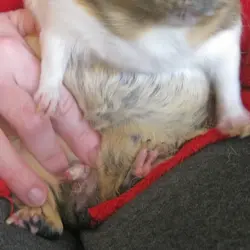
Merrypip's Angus showing debris & hair around the penis

- Penis (Prongs, 'cauliflower willy, strangled and prolapsed penis)
- Semen fluid (Semen rods and 'boar glue')
- Smegma
2 Perianal Sac and Impaction
- White paste in anal sac
- Impaction
- Fly strike
3 Testicles and Neutering Post-op Complications
- Testicles (descending, undescended and swellings in the area)
- Neutering post-op complications
4 Nipples and Mammary Tumours
- Nipples and belly button
- Mammary tumours
5 Grease Gland
This guide is a collection of information that addresses boar specific problems of mainly the reproductive tract and anal sac. It will hopefully make it easier for you to work out what is going on and when to see a vet.
We strongly recommend to get into the habit of a weekly weigh-in, body check and any necessary grooming. Some boars can be very messy and may need more frequent attention (especially with impaction or as teenagers) while others only need a thorough check once a month. We do however recomment that you have a weekly feel of the penis area of any hard bits (smegma or rods) as well as checking the the anal sac (which in neutered boars is much smaller), grease gland and the usual cuddling body feel that gently covers the whole body when feeling for lumps or anything unusual.
Our Boar Care guide with lots of pictures is there to help with the regular care side of boar maintenance:
1 How do boar genitalia look like?
- Babies, boars with descended testicles and neutered boars (pictures)
- Nipples
- Sexing Guide link
2 Bums
- What is normal
- How to keep clean
- Impaction
3 Bits and Pieces (Penis and semen fluid)
- What is normal
- Removing smegma and dirt from the penis
- Penis prongs...
- Babies, boars with descended testicles and neutered boars (pictures)
- Nipples
- Sexing Guide link
2 Bums
- What is normal
- How to keep clean
- Impaction
3 Bits and Pieces (Penis and semen fluid)
- What is normal
- Removing smegma and dirt from the penis
- Penis prongs...
- MerryPip
- Replies: 4
- Forum: Grooming Care & Health Monitoring
We also recommend to take reference pictures once a year to save in a special so you can look up how your boy's 'normal' looks when you have concerns about any body part.
1 Penis and semen fluid
The penis is surrounded and protected by the internal tissue of the penis shaft. The round 'button' you see when you look at the genitalia is actually sac tissue and not the penis itself. In order to look at the penis, you need to express it fully by gently pushing on the hard penis shaft under the skin from the belly side towards the opening. Because it is a proteced place, semen fluid, grease and dirt can build up. In never checked boars this can build up to the degree that an rather nasty infection/abscess can come up. Any swelling in the groin area needs to be vet checked.
Penis
Prongs
- Guinea pig boars have two protrusions on their penis, like horns. This is another variation of ‘normal’ so is nothing to worry about!
- They are very often not visible upon penis inspection, but boars use them to keep hold of a moving sow when they mate.
- Some boars have only got one or no prongs at all.
However, the absence of prongs is NOT an indication of a boar's infertility, as veterinary textbooks maintain without substantion. There is some rather happily wheeking verifiable proof that says otherwise.
Picture from Stewybus showing one penis prong

Cauliflower willy'
-‘Cauliflower willy’ is the term used when the foreskin isn’t as tidy and is more ‘frilly’ in appearance. This may (or may not) mean that it is trickier to keep clean and occasionally the penis itself protrudes which can cause it to get caught or damaged unintentionally.
- In this case your boar would need more frequent checks (at least daily) to make sure everything is safe and healthy.
- Also see a vet if you notice changes to the willy (infection).
Picture from MintyandGary

Merrypip's Angus showing debris & hair around the penis

Strangled Penis
Please always check for problems if your boy seems to be constantly fussing about his penis. Boars do masturbate but nonstop attention can be a sign that there is a problem/pain issue in the penis shaft.
Make sure there is nothing caught around the shaft that could interfere with blood flow; especially if you have long-haired piggies in the same cage. The penis will show a blueish colour past the obstruction if the circulation is compromised. The consequences of a cut-off circulation are dire.
See a vet asap if you cannot remove any tightly looped hair yourself! This is an emergency.
The normal colour for a penis tip is dark ruby into maroon (see Hywel's picture above).
Prolapsed penis
-The penis can sometimes not retract properly. Generally the problem rights itself. With a boar with a more persistent retraction problem, a lubricating human gel like KY gel can help.
- In some cases the penis cannot retract itself and hangs out permanently. It needs stitching back by a vet to prevent the risk of injuries and infection. It is a minor procedure and not a full-blown operation.
Semen fluid
'Boar glue' (Ejaculated semen fluid)
- Boars can ejaculate both when humping and on other occasions. The semen they leave behind is a very sticky substance and dries solid, hence the term ‘boar glue’. You will often find blobs of shiny white dried boar glue on a boar's or their companion's noses or stuck to the fur.
- If it has not yet dried, it is possible to remove it by washing or a damp cloth but once dried (especially into fur) then removal is difficult and often using scissors to carefully cut the offending lump out of the fur is the best bet; if that is not possible, you may have to wait for it to fall off on it own!
Sperm rods (Dried semen fluid in the penis shaft)
- Semen can also dry into a thin rod inside penis, known as a ‘sperm rod’. The ends of these are often protruding from the external part of the penis.
- Small sperm rods can be carefully removed, just as you would with a stray piece of hay or bedding.
- For removing a large sperm rod (which can be very painful and may have caused some infection) please see a vet! Large sperm rods can even cause loss of appetite.
Furryfriends' Monty's large sperm rod

Smegma
- The penis is often covered in a creamy/white/greyish material called smegma. This shouldn’t be excessive or particularly smelly.
If excessive smegma is left to build up for too long, it can dry out and form a hard crust around the penis.
- Any stray hairs, hay or other material should be removed as they could loop around the shaft or scratch it and cause an infection.
Wiebke's Hywel with an exressed penis showing smegma and the usual stray bits of hay and hair in the tip of the penis as you are likely to find with your own boars when checking on them.

Merrypip's Angus showing debris & hair around the penis

